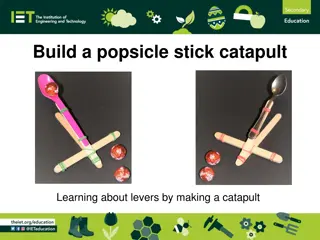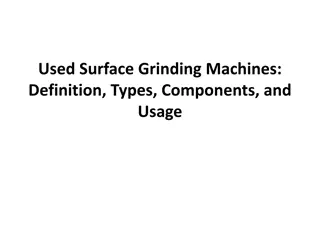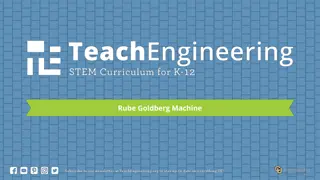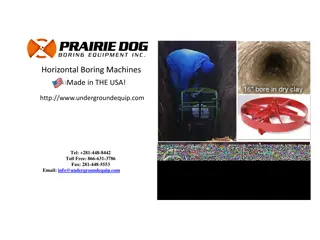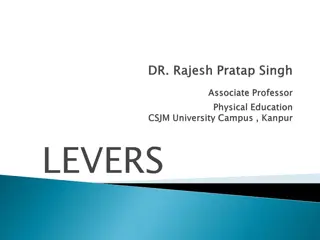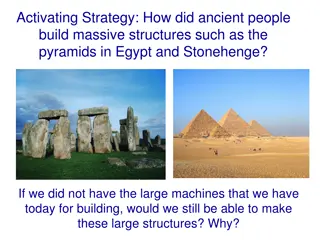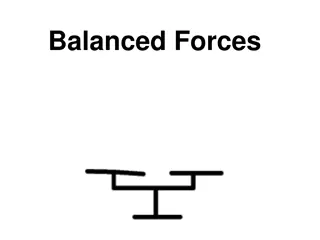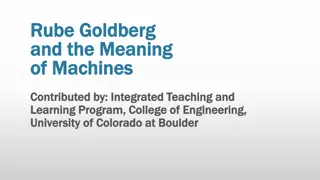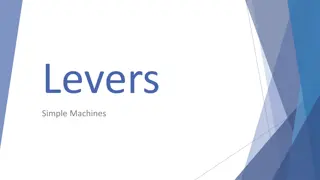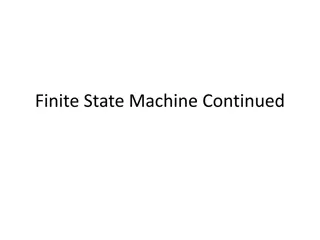Understanding Levers and Simple Machines in Physics
Explore the world of levers, simple machines, and mechanical advantage in this detailed overview. Learn about the different types of levers, how they work, and the concept of mechanical advantage. Discover the three classes of levers and how they differ in their input and output forces. Gain insights into the principles behind these fundamental tools of physics.
Download Presentation

Please find below an Image/Link to download the presentation.
The content on the website is provided AS IS for your information and personal use only. It may not be sold, licensed, or shared on other websites without obtaining consent from the author. Download presentation by click this link. If you encounter any issues during the download, it is possible that the publisher has removed the file from their server.
E N D
Presentation Transcript
Levers and Equilibrium Version: 12.16.19
Machines A device that makes work easier. A machine can change the size, the direction, or the distance over which a force acts. Version: 12.16.19
Simple Machines 1. Lever: A bar that is free to pivot, or move about a fixed point when an input force is applied. 2. Wheel and Axle: Consists of 2 discs or cylinders, each one with a different radius. 3. Inclined plane: a slanted surface along which a force moves an object to a different elevation 4. Wedge: a V-shaped object whose sides are two inclined planes sloped toward each other. 5. Screw: an inclined plane wrapped around a cylinder. 6. Pulley: A chain, belt , or rope wrapped around a wheel. Version: 12.16.19
Levers A bar that is free to pivot, or move about a fixed point when an input force is applied. Fulcrum = the pivot point of a lever. INPUT FORCE (Effort Force) There are three classes of levers based on the positioning of the effort force, resistance force, and fulcrum. OUTPUT FORCE (Resistance Force) INPUT ARM (Effort Distance) OUTPUT ARM (Resistance Distance) FULCRUM Version: 12.16.19
Levers In the lever, the work (Force displacement) done at one end is equal to the work done on the load at the other end. Version: 12.16.19
Three Classes of Levers For a type 1 lever, push down on one end and you lift a load at the other. The directions of input and output are opposite. Version: 12.16.19
Three Classes of Levers For a type 2 lever, you lift the end of the lever. Since the input and output forces are on the same side of the fulcrum, the forces have the same direction. Version: 12.16.19
Three Classes Levers For a type 3 lever, the input force is applied between the fulcrum and the load. The input and output forces are on the same side of the fulcrum and have the same direction. Version: 12.16.19
Mechanical Advantage Mechanical Advantage is the number of times a machine multiplies the input force. Ratio of the output force compared to the input force. ??????? ?????? ?? = There are two types of mechanical advantage IDEAL Involves no resistance. Is calculated differently for different machines Usually input distance/output distance ACTUAL Involves resistance. Calculated the same for all machines Version: 12.16.19
?? =??????? ?????? ??? ??????? ??? = INPUT FORCE (EFFORT FORCE) ?????? OUTPUT FORCE (Resistance Force) INPUT ARM (EFFORT DISTANCE) OUTPUT ARM (RESISTANCE DISTANCE) FULCRUM Version: 12.16.19
Different mechanical advantages: MA equal to one. (Foutput = Finput) Change to the direction of the applied force only. MA less than one An increase in the distance an object is moved (doutput) Version: 12.16.19
Forces and Interaction In the simplest sense, a force is a push or a pull. A mutual action is an interaction between one thing and another. The interaction that drives the nail is the same as the one that halts the hammer. Version: 12.16.19
Forces and Interactions cont., A hammer exerts a force on the nail and drives it into a board. There must also be a force exerted on the hammer to halt it in the process. Newton reasoned that while the hammer exerts a force on the nail, the nail exerts a force on the hammer. In the interaction, there are a pair of forces, one acting on the nail and the other acting on the hammer. Version: 12.16.19
Newtons Third Law Newton s third law is often stated: To every action there is always an equal opposing reaction. Newton s third law describes the relationship between two forces in an interaction. One force is called the action force. The other force is called the reaction force. Neither force exists without the other. They are equal in strength and opposite in direction. They occur at the same time (simultaneously). It doesn t matter which force we call action and which we call reaction. Version: 12.16.19
Identifying Action Reaction Pairs When action is A exerts force on B, the reaction is simply B exerts force on A. Version: 12.16.19
Action Reaction Pairs cont., A football is kicked. a. A acts on B and B accelerates. b. Both A and C act on B. They can cancel each other so B does not accelerate. Version: 12.16.19
Action Reaction Pairs cont., Version: 12.16.19


